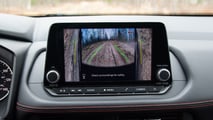
I’m fascinated by the Nissan Rogue. At face value, it’s merely an average vehicle. It’s not powerful, it's not elegant, it’s not especially attractive, and it doesn’t really have any cool features. Not to mention it’s getting old. The current Rogue debuted in 2020 with a 7.0-inch touchscreen, which grew to 8.0 inches for most trims in 2024. That’s the same size as the cheap aftermarket double-din stereo in my 2004 Subaru Forester.
I say these things not to dunk on Nissan—the opposite, in fact. The Rogue is one of the best-selling SUVs in the United States despite its perceived averageness. Having recently spent a week in the Rogue Rock Creek Edition with its analog gauges and small center screen, I found myself falling under its charm. It made me ask a serious question: As automakers battle for technological supremacy, is Nissan’s simpler approach to tech the best way to go?
| Quick Specs | 2025 Nissan Rogue Rock Creek |
| Touchscreen / Instrument Cluster | 8.0 Inches / Analog |
| Apple CarPlay / Android Auto | Wired |
| Voice Control | Yes |
For the record, you can get more tech in the Rogue. SL and Platinum trims have a digital cockpit with a 12.3-inch infotainment screen running Google Built-In, among other things. But the Rogue’s bread and butter lineup—S, SV, and now the Rock Creek featured here—soldier on with an 8.0-inch screen as the only available choice. Mounted tablet style, it’s a dated design with knobs on the sides and buttons underneath. It sits in an awkward dash cutout that reminds you of the larger screen you can’t get.
What else can’t you get? There is no native navigation system, no wireless CarPlay or Android Auto, and you won’t be downloading apps for your favorite streaming music service. The display comes to life as shades of gray with a customizable home screen, though your custom choices are largely clock styles and your preferred audio source. For a mid-level SUV trim in 2025, the Rogue Rock Creek is very thin when it comes to infotainment services.
CarPlay and Android Auto are available, provided you plug your phone in. If you simply want to run your choice of Spotify playlist, Bluetooth connectivity is a choice. The Rock Creek also serves as a Wi-Fi hotspot, and if you forget your phone at home, SiriusXM is installed and ready, so long as you have a subscription. Naturally, you can access various vehicle settings through the screen, everything from phone connections to sound levels and NissanConnect Services. The infotainment system might be low-frills, but it still plugs into the automaker for over-the-air updates.
Here’s the thing. Do you really need a dash-sized touchscreen filled with apps? Is a native navigation system really necessary in the age of smartphones? Is it more convenient to control all climate settings and other common-use features through a large screen with multiple widgets? Or is a simple interface that relies on your personal mobile device the best way to go?

Pros: Simple To Use, Intuitive, Off-Road Cameras Actually Work For Off-Roading
All things being equal, the simpler solution is usually the better one, and Nissan’s base infotainment system is very simple to use. I was grateful for this in my first Rogue Rock Creek outing in late 2024, a Nissan-hosted event where I had all of 30 seconds to familiarize myself with the tech before embarking on an hour-long off-road drive. And that’s all it took to cover pretty much everything, courtesy of the clearly labeled buttons under the display.
Want to activate the external cameras? Push the camera button. Not happy with the audio? Push the audio button. Windshield fogging up? You don’t even need the screen for that—all the climate settings are buttons and knobs in the middle of the dash. And there’s a fair amount of redundancy in the system, too. For example, you can adjust sound levels by pushing the settings button and navigating to sound. Or you can just push the tune/scroll knob and jump in right away.
Speaking of the external cameras, Rock Creek gets a set of three off-road cameras you won’t find on other trims, and I’m here for it. Even if you don’t embark down narrow, muddy trails, dual mirror-mounted cameras facing down provide an outstanding view of the Rogue’s front wheels. This is an ideal system for parallel parking, showing you just how close you are to the curb.

There’s a third camera in the grille that offers a forward view of the ground immediately in front. Should you find yourself climbing a steep hill, the camera will see the terrain on the other side long before you do. Once again, though, I see this being far more useful in urban adventures, showing you the tricycle that was abandoned right in front of the bumper. And there’s a simple camera button to push when you need to see the action—or they come on automatically below 12 mph in off-road mode.
If you’re digital-minded, the system is simple and intuitive to use. If you’re analog-minded, it’s also intuitive to use. Just a few weeks later, I was behind the wheel of a new Cadillac Escalade, where I spent five minutes trying to override the autolamp feature and turn on the headlights. Take that as you will.

Cons: Smallish Screen, Wired CarPlay/Auto, Pretty Much Nothing Without A Phone
The off-road cameras are fantastic, but they emphasize the biggest detractor of Nissan’s simple system. I’m speaking of the small 8.0-inch screen, which displays the forward-looking camera just enough to be useful. At a glance, you can get a good idea of what’s immediately ahead. The same cannot be said for the wheel-view cameras, which take up the very edges of the screen on their respective sides.
If you’re on a tight trail, tree limbs and small obstacles are tough to see even if you’re just crawling along. I found it most effective only after coming to a complete stop, identifying the obstacles, and slowly moving forward. To Nissan’s defense, this system was designed for slow-speed use. But if these cameras were displayed on Nissan’s larger 12.3-inch screen, it would be a far more effective tool for drivers.
And then there’s the lack of wireless connectivity for CarPlay or Auto. Perhaps it’s a small point, but in a $35,000 SUV, there’s no reason not to have it. That said, I had no connectivity issues with either Nissan launching Android Auto or detecting my phone for Bluetooth operation. Touch commands had little to no lag, but voice control wasn’t quite as useful. Simply waking the system up often required a couple of prompts before Google responded, and I had a few issues finding contacts for outbound calls.
It wasn’t the best voice experience I’ve had, but it wasn’t the worst, either. With a little patience, I could set destinations for Google Maps and make phone calls while on the move. At the end of the day, that’s mostly what average drivers are doing anyway, be it through Apple or Android.
I’ll be the first to admit this all sounds very… average. But there’s a method behind Nissan’s motives here that makes sense.


I spoke to Nissan during the Rogue Rock Creek first drive about the decision to stay light on tech. The company believes a vast majority of drivers connect their phones to their cars regardless of the tech already installed, so why spend the extra money for things people won’t use? That’s why Nissan’s less expensive models like the Kicks, Sentra, and certain Rogue trims have such a basic system. Yes, without a phone, it’s little more than a stereo with an 8.0-inch screen. But with a phone—which just about everyone has—it’s as useful as the latest version of CarPlay or Auto.
After my initial meh moment with the lack of tech, it wasn’t long before I was appreciating the simplicity of it all. I could adjust the volume, change stations, or advance songs without taking my eyes off the road. Adjusting temperature settings didn’t require a hard look at a screen to see where to touch. I didn’t have to search for camera views when parking or scrambling down narrow trails. With my phone connected, I could call or text anyone in my contacts list hands-free. And I had arguably the best navigation system currently available.

At the end of my week in the Rogue Rock Creek, Nissan won me over. Simpler is better, and I suspect I’m not the only one who feels that way. Nissan sold 245,724 Rogues last year in America; it’s the company’s best-selling vehicle by a wide margin, and it’s the third best-selling SUV in the country, behind the Toyota RAV4 and Honda CR-V. That’s a decidedly above-average take rate for this average SUV, and I think other automakers can learn a lesson from all this.
You don’t have to be clever to attract buyers. Just give people what they want in a simple package. That’s the Rogue Rock Creek in a nutshell, basic infotainment system and all.
Gallery: 2025 Nissan Rogue Rock Creek Edition Review














